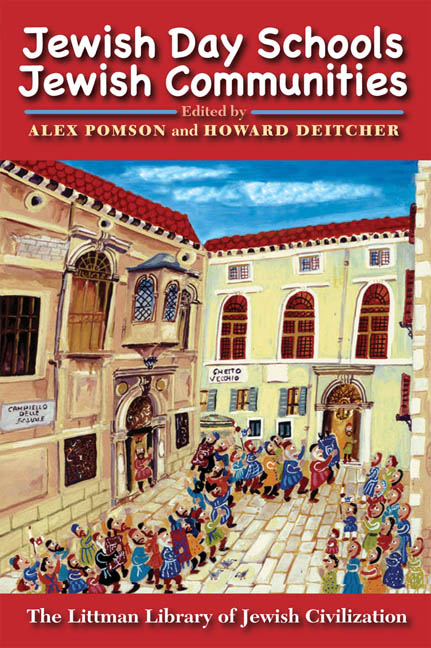Book contents
- Frontmatter
- Dedication
- Acknowledgements
- Contents
- Note on Transliteration
- Introduction: Jewish Schools, Jewish Communities: A Reconsideration
- PART I Insights from Public and General Education
- PART II Cross-Cultural Insights
- PART III Insights through the Prism of Community
- 13 Relationships between Schools and Parents in Haredi Popular Literature in the United States
- 14 The Impact of Community on Curriculum Decision-Making in a North American Jewish Day School
- 15 Ideological Commitment in the Supervision of Jewish Studies Teachers: Representing Community
- 16 Schooling for Change in the Religious World: An Educational Experiment in a Religious Junior High School in Israel
- 17 Home-Made Jewish Culture at the Intersection of Family Life and School
- 18 Teacher Perspectives on Behaviour Problems: Background Influences on Behavioural Referral Criteria and Definitions of Rebellious Behaviour
- 19 Shabbatonim as Experiential Education in the North American Community Day High School
- 20 Teaching Leadership through Town Meeting
- 21 Building Community in a Pluralist High School
- Contributors
- Index
17 - Home-Made Jewish Culture at the Intersection of Family Life and School
from PART III - Insights through the Prism of Community
- Frontmatter
- Dedication
- Acknowledgements
- Contents
- Note on Transliteration
- Introduction: Jewish Schools, Jewish Communities: A Reconsideration
- PART I Insights from Public and General Education
- PART II Cross-Cultural Insights
- PART III Insights through the Prism of Community
- 13 Relationships between Schools and Parents in Haredi Popular Literature in the United States
- 14 The Impact of Community on Curriculum Decision-Making in a North American Jewish Day School
- 15 Ideological Commitment in the Supervision of Jewish Studies Teachers: Representing Community
- 16 Schooling for Change in the Religious World: An Educational Experiment in a Religious Junior High School in Israel
- 17 Home-Made Jewish Culture at the Intersection of Family Life and School
- 18 Teacher Perspectives on Behaviour Problems: Background Influences on Behavioural Referral Criteria and Definitions of Rebellious Behaviour
- 19 Shabbatonim as Experiential Education in the North American Community Day High School
- 20 Teaching Leadership through Town Meeting
- 21 Building Community in a Pluralist High School
- Contributors
- Index
Summary
THE INTERACTIONS between parents and schools occur in two locations: at school itself, where parents come into direct contact with school life, and at home, where children literally and figuratively transport school back to their families in their knapsacks. It is clear to those who have studied or sought to cultivate these interactions that their overriding purpose is to support the work of schools with children.
Having completed a four-year study of the relationships between parents and their children's Jewish day schools, we are convinced that these interactions also possess no small significance for parents’ own lives and for their communities. We will not reproduce the major findings of our study here, but want to pay attention in this chapter to one of our most unexpected discoveries: that what children bring back from school can serve as an important resource for the nurture of Jewish social and cultural capital in the home.
This finding was unexpected because we embarked on our study aware of more than four decades of sociological research demonstrating that schools are generally weak socializing agents when it comes to their impact on children's lives, especially when compared with the influence of families. At the outset we did not, therefore, expect that what children brought home from school might result in changes to the Jewish lives of their parents. Such an outcome, we will show, calls into question two commonplace assumptions that undergird the work of those who study and develop ‘school–community connections’: first, that there is a generally unidirectional sequence of cause and effect (from home to school) in the relationships between communities/parents and schools; and second, that the primary outcomes of these relationships have greater significance for children than for parents. At the same time, we suggest, these outcomes confirm an emerging strand of thought within the study of contemporary Jewry, one that emphasizes the fluidity of adult Jewish identities, even—if not especially— among those who may not have previously been deeply engaged with aspects of Jewish life.
Background
Our study was conducted between 2002 and 2006 in and around the Downtown Jewish Day School (DJDS), a private, religiously pluralistic Jewish elementary school in Toronto, Canada.
- Type
- Chapter
- Information
- Jewish Day Schools, Jewish CommunitiesA Reconsideration, pp. 307 - 323Publisher: Liverpool University PressPrint publication year: 2009

